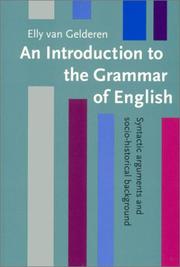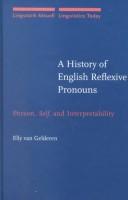| Listing 1 - 10 of 12 | << page >> |
Sort by
|
Book
ISBN: 9789027255297 9789027289216 9027289212 9027255296 1282245244 9781282245242 9786612245244 6612245247 Year: 2009 Publisher: Amsterdam Benjamins
Abstract | Keywords | Export | Availability | Bookmark
 Loading...
Loading...Choose an application
- Reference Manager
- EndNote
- RefWorks (Direct export to RefWorks)
Linguistic Cycles are ever present in language change and involve a phrase or word that gradually disappears and is replaced by a new linguistic item. The most well-known cycles involve negatives, where an initial single negative, such as not, is reinforced by another negative, such as no thing, and subjects, where full pronouns are reanalyzed as endings on the verb. This book presents new data and insights on the well-known cyclical changes as well as on less well-known ones, such as the preposition, auxiliary, copula, modal, and complementation cycles. Part I covers the negative cycle with chapters looking in great detail at the steps that are typical in this cycle. Part II focuses on pronouns, auxiliaries, and the left periphery. Part III includes work on modals, prepositions, and complementation. The book ends with a psycholinguistic chapter. This book brings together linguists from a variety of theoretical frameworks and contributes to new directions in work on language change.
Grammar --- Grammar, Comparative and general --- Linguistic change. --- Syntax. --- 801.5 --- Grammatica --- 801.5 Grammatica --- Linguistic change --- Change, Linguistic --- Language change --- Historical linguistics --- Language and languages --- Syntax --- Linguistics --- Philology --- Grammar, Comparative and general Syntax
Multi
ISBN: 9781107017740 9781107659810 9781139084628 Year: 2013 Publisher: Cambridge Cambridge University Press
Abstract | Keywords | Export | Availability | Bookmark
 Loading...
Loading...Choose an application
- Reference Manager
- EndNote
- RefWorks (Direct export to RefWorks)
Grammar --- Grammar, Comparative and general --- Clauses. --- Principles and parameters (Linguistics) --- Propositions (Linguistique) --- Syntaxe --- Principes et paramètres (Linguistique) --- Syntax. --- Principes et paramètres (Linguistique) --- Generative grammar --- Language and languages --- Syntax --- Clauses --- Sentences --- Linguistics --- Philology --- Grammar, Comparative and general Syntax

ISBN: 9027227950 1588115526 9786612160332 1282160338 9027295328 9789027295323 9789027227959 9781588115522 Year: 2004 Publisher: Amsterdam Benjamins
Abstract | Keywords | Export | Availability | Bookmark
 Loading...
Loading...Choose an application
- Reference Manager
- EndNote
- RefWorks (Direct export to RefWorks)
This book provides much detail on the changes involving the grammaticalization of personal and relative pronouns, topicalized nominals, complementizers, adverbs, prepositions, modals, perception verbs, and aspectual markers. It accounts for these changes in terms of two structural economy principles. Head Preference expresses that single words, i.e. heads, are used to build structures rather than full phrases, and Late Merge states that waiting as late as possible to merge, i.e. be added to the structure, is preferred over movement. The book also discusses grammar-external processes (e.g. prescriptivist rules) that inhibit change, and innovations that replenish the grammaticalized element. Most of the changes involve the (extended) CP and IP: as elements grammaticalize clause boundaries disappear. Cross-linguistic differences exist as to whether the CP, IP, and VP are all present and split and this is formulated as the Layer Principle. Changes involving the CP are typically brought about by Head Preference, whereas those involving the IP and VP by Late Merge.
Grammar --- LANGUAGE ARTS & DISCIPLINES --- Linguistics / General --- Grammar, Comparative and general --- Economy (Linguistics) --- Linguistic change --- Languages & Literatures --- Philology & Linguistics --- Linguistics --- Philology --- Historical linguistics --- Language and languages --- Efficiency (Linguistics) --- Linguistic economy --- Linguistic analysis (Linguistics) --- Grammaticalization --- Linguistic change. --- Grammaticalization.

ISBN: 9027225885 9789027225863 9027225869 1588112004 Year: 2002 Publisher: Amsterdam : Benjamins,
Abstract | Keywords | Export | Availability | Bookmark
 Loading...
Loading...Choose an application
- Reference Manager
- EndNote
- RefWorks (Direct export to RefWorks)
This Introduction provides a lively and clearly written textbook. It introduces basic concepts of grammar in a format which inspires the reader to use linguistic arguments. The style of the book is engaging and examples from poetry, jokes, and puns illustrate grammatical concepts.The focus is on syntactic analysis and evidence. However, special topic sections contribute sociolinguistic and historical reasons behind prescriptive rules such as the bans on split infinitives, dangling participles, and preposition stranding.The book is structured for a semester-long course. It provides exercises, keys to those exercises, and sample exams. It also includes a comprehensive glossary and suggestions for further reading.
English language --- Grammar --- Sociolinguistics --- LANGUAGE ARTS & DISCIPLINES --- Linguistics / General --- 802.0-56 --- #KVHA:Grammatica; Engels --- Engels: syntaxis; semantiek --- 802.0-56 Engels: syntaxis; semantiek --- ANGLAIS (LANGUE) --- GRAMMAIRE --- GRAMMAIRE HISTORIQUE --- SYNTAXE --- ASPECT SOCIAL
Book
ISBN: 9027232377 9789027232373 9027232369 9786612155369 1282155369 9027293244 9789027293244 9789027232366 9781282155367 6612155361 Year: 2006 Publisher: Amsterdam: Benjamins,
Abstract | Keywords | Export | Availability | Bookmark
 Loading...
Loading...Choose an application
- Reference Manager
- EndNote
- RefWorks (Direct export to RefWorks)
This exceptionally clear text focuses on internal changes in the English language. It outlines the history of English from pre-Old English times to the present. Not only does it present the traditional morphological descriptions of the various stages of the language, it provides many example sentences, texts, and cartoons that are analyzed for the benefit of the student and which make this book ideal for class use. Some language-external topics are covered such as early printing and authorship debates. Tables and figures complement the material covered and exercises review the main points as well as ask further, more challenging, questions. Answers to the exercises are provided, as is a time line listing some of the external events, and some guidance on how to use the OED. Complementary web site information is provided throughout the book, and a companion web site accompanies the book.
English language --- History --- Historical linguistics --- 802.0-02 --- 802.0 --- 802.0 Engels. Engelse taalkunde --- Engels. Engelse taalkunde --- 802.0-02 Engels. Engelse taalkunde--?-02 --- Engels. Engelse taalkunde--?-02 --- Germanic languages --- History. --- English language - History --- English language - History - Problems, exercises, etc. --- ANGLAIS (LANGUE) --- HISTOIRE --- PROBLEMES, EXERCICES, ETC
Book
ISBN: 9780199756049 9780199756056 Year: 2011 Publisher: Oxford Oxford University Press
Abstract | Keywords | Export | Availability | Bookmark
 Loading...
Loading...Choose an application
- Reference Manager
- EndNote
- RefWorks (Direct export to RefWorks)
Elly van Gelderen provides examples of linguistic cycles from a number of languages and language families, along with an account of the linguistic cycle in terms of minimalist economy principles. A cycle involves grammaticalization from lexical to functional category followed by renewal. Some well-known cycles involve negatives, where full negative phrases are reanalyzed as words and affixes and are then renewed by full phrases again. Verbal agreement is another example: full pronouns are reanalyzed as agreement markers and are renewed again. Each chapter provides data on a separate cycle from a myriad of languages. Van Gelderen argues that the cross-linguistic similarities can be seen as Economy Principles present in the initial cognitive system or Universal Grammar. She further claims that some of the cycles can be used to classify a language as analytic or synthetic, and she provides insight into the shape of the earliest human language and how it evolved.
Linguistic change. --- Linguistics --- Changement linguistique

ISBN: 128216337X 9786612163371 902729917X 9789027299178 9781556199882 1556199880 9789027227607 9027227608 9781282163379 9027227608 1556199880 Year: 2000 Publisher: Amsterdam : Benjamins,
Abstract | Keywords | Export | Availability | Bookmark
 Loading...
Loading...Choose an application
- Reference Manager
- EndNote
- RefWorks (Direct export to RefWorks)
This book brings together a number of seemingly distinct phenomena in the history of English: the introduction of special reflexive pronouns (e.g. myself), the loss of verbal agreement and pro-drop, and the disappearance of morphological Case. It provides vast numbers of examples from Old and Middle English texts showing a person split between first, second, and third person pronouns. Extending an analysis by Reinhart & Reuland, the author argues that the 'strength' of certain pronominal features (Case, person, number) differs cross-linguistically and that parametric variation accounts for the changes in English. The framework used is Minimalist, and Interpretable and Uninterpretable features are seen as the key to explaining the change from a synthetic to an analytic language.
English language --- 802.0-02 --- 802.0-56 --- 802.0-02 Engels. Engelse taalkunde--?-02 --- Engels. Engelse taalkunde--?-02 --- Grammar, Historical --- Pronoun --- Reflexives --- Engels: syntaxis; semantiek --- Reciprocals --- Relative pronoun --- Nominals --- 802.0-56 Engels: syntaxis; semantiek --- Grammar, Historical. --- Pronoun. --- Reflexives. --- Germanic languages --- ANGLAIS (LANGUE) --- HISTOIRE
Book
ISBN: 1107241308 1139084623 1107017742 1107659817 Year: 2013 Publisher: Cambridge : Cambridge University Press,
Abstract | Keywords | Export | Availability | Bookmark
 Loading...
Loading...Choose an application
- Reference Manager
- EndNote
- RefWorks (Direct export to RefWorks)
Clause structure is the most widely-studied phenomenon within syntactic theory, because it refers to how words and phrases are embedded within a sentence, their relationships to each other within a sentence, and ultimately, how sentences are layered and represented in the human brain. This volume presents a clear and up-to-date overview of the Minimalist Program, synthesizes the most important research findings, and explores the major shifts in generative syntax. As an accessible topic book, it includes chapters on framework, the clause in general, and the semantic, grammatical and pragmatic layers. Designed for graduate students and researchers interested in syntactic theory, this book includes a range of examples taken from data acquisition, typology and language change, alongside discussion questions, helpful suggestions for further reading and a useful glossary.
Grammar, Comparative and general --- Principles and parameters (Linguistics) --- Generative grammar --- Language and languages --- Syntax --- Clauses --- Clauses. --- Syntax. --- Sentences --- Arts and Humanities --- Language & Linguistics --- Linguistics --- Philology --- Grammar, Comparative and general Syntax
Multi
ISBN: 9781108831161 9781108926409 9781108923408 1108918336 1108923402 1108924468 1108831168 Year: 2022 Publisher: Cambridge Cambridge University Press
Abstract | Keywords | Export | Availability | Bookmark
 Loading...
Loading...Choose an application
- Reference Manager
- EndNote
- RefWorks (Direct export to RefWorks)
In this pioneering study, a world-renowned generative syntactician explores the impact of phenomena known as 'third factors' on syntactic change. Generative syntax has in recent times incorporated third factors - factors not specific to the language faculty - into its framework, including minimal search, labelling, determinacy and economy. Van Gelderen's study applies these principles to language change, arguing that change is a cyclical process, and that third factor principles must combine with linguistic information to fully account for the cyclical development of 'optimal' language structures. Third Factor Principles also account for language variation around that-trace phenomena, CP-deletion, and the presence of expletives and Verb-second. By linking insights from recent theoretical advances in generative syntax to phenomena from language variation and change, this book provides a unique perspective, making it essential reading for academic researchers and students in syntactic theory and historical linguistics.
Dialectology --- Grammar --- Language and languages --- Grammar, Comparative and general --- Linguistic change --- Historical linguistics --- Grammar, Comparative and general Syntax --- Syntax --- Characterology of speech --- Language diversity --- Language subsystems --- Language variation --- Linguistic diversity --- Variation in language --- Variation --- Linguistic change. --- Variation. --- Syntax.
Book
ISBN: 1003272568 1000912221 1003272568 Year: 2023 Publisher: New York, NY : Routledge,
Abstract | Keywords | Export | Availability | Bookmark
 Loading...
Loading...Choose an application
- Reference Manager
- EndNote
- RefWorks (Direct export to RefWorks)
Linguistic change. --- Grammar, Comparative and general --- Cycles. --- Grammaticalization.
| Listing 1 - 10 of 12 | << page >> |
Sort by
|

 Search
Search Feedback
Feedback About UniCat
About UniCat  Help
Help News
News